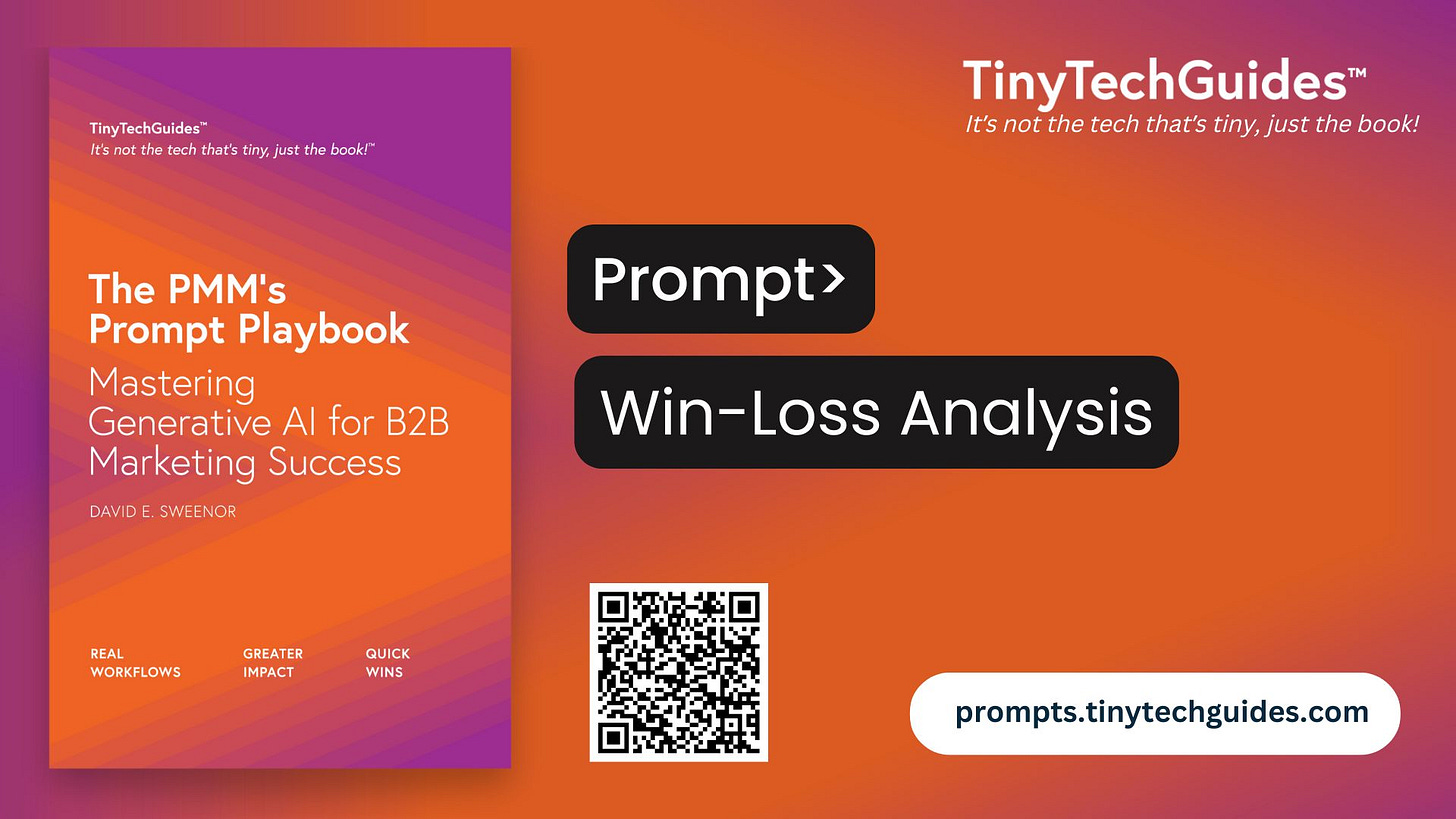Prompt Workflow: Win-Loss Analysis
Audience Understanding
Win-Loss Analysis
This prompt, along with 30 others, is included in The PMM’s Prompt Playbook. These cut-and-paste prompts, along with bonus prompts not in the book, will be made available to paid subscribers on a weekly basis.
Get the PMM’s Prompt Playbook and Modern B2B Marketing today!
What does this do?
The Win-Loss Analysis workflow helps businesses uncover why deals are won or lost by analyzing sales data, customer feedback, and competitor positioning. It identifies patterns in decision-making, highlights areas for improvement in messaging and product strategy, and provides actionable insights for sales enablement. By systematically evaluating deal outcomes, this process helps refine go-to-market strategies and strengthen competitive positioning.
Workflow Steps
Collect and categorize win-loss data from CRM, sales notes, and customer feedback
Identify top reasons deals are won (e.g., product strengths, pricing, service quality)
Identify top reasons deals are lost (e.g., competitor differentiation, objections, price concerns)
Analyze patterns and recurring themes across multiple deals
Simulate customer and competitor perspectives for deeper insights
Prioritize insights based on frequency, impact, and strategic importance
Develop recommendations for sales, product, and messaging improvements
Summarize findings to guide future sales strategies and positioning
Define your inputs
{industry=Insert your target industry, e.g., enterprise cybersecurity solutions.}{solution=Insert your product/solution, e.g., threat detection platform.}{audience=Insert your target audience, e.g., CISOs, IT security managers, procurement teams.}{data=Insert required data sources, e.g., CRM deal records, sales interview notes, customer feedback, post-mortem reports.}
Define the objective
<role/>
You are a win-loss analysis expert helping a product marketing team uncover why deals are won or lost for {solution} in the {industry}.
</role>
<context/>
I need to analyze win-loss data to identify patterns, reasons for success or failure, and opportunities for improving our sales process, product messaging, and positioning. The goal is to refine strategy, better align with customer needs, and address competitive challenges.
</context>
<task/>
Using the following win-loss data: [Insert data sources: CRM deal outcomes, sales call notes, customer feedback, and reasons tagged in closed/lost records.]
-Identify the top reasons deals are won (e.g., product features, pricing, support).
-Identify the top reasons deals are lost (e.g., competitor strengths, objections, pricing concerns).
-Summarize recurring themes or patterns in the data.
-Provide actionable insights and recommendations for sales enablement, messaging improvements, and product development.
</task>
<format>
Provide the response as follows:
Top reasons deals were won:
○ Reason 1: [Description].
○ Reason 2: [Description].
Top reasons deals were lost:
○ Reason 1: [Description].
○ Reason 2: [Description].
Recurring themes:
○ Theme 1: [Patterns observed].
○ Theme 2: [Patterns observed].
Actionable recommendations:
○ Recommendation 1: [Sales enablement or messaging improvement].
○ Recommendation 2: [Product feature or competitive adjustment].
</format>
<tone>
Professional, analytical, and results-driven.
</tone>
Analyze sales call notes and customer feedback
<role/>
You are a customer insights analyst summarizing patterns from sales call notes and customer feedback related to won and lost deals.
</role>
<context/>
I need you to analyze qualitative data, including sales call transcripts and post-mortem feedback, to extract recurring reasons for deal outcomes. Focus on identifying why customers chose or rejected {solution}.
</context>
<task/>
Analyze the following notes and feedback: [Insert data: sales call transcripts, customer quotes, survey feedback.]
-For won deals: Identify common themes or statements about what influenced the decision to purchase.
-For lost deals: Identify recurring objections, concerns, or mentions of competitors that led to the loss.
-Highlight any patterns related to product features, pricing, messaging, or sales process.
</task>
<format>
Provide the response in bullet points:
-Reasons for won deals:
o [Key factor 1].
o [Key factor 2].
-Reasons for lost deals:
o [Key factor 1].
o [Key factor 2].
-Recurring patterns:
o [Theme 1: e.g., “Pricing concerns were most common among SMBs.”]
o [Theme 2: e.g., “Competitor X’s ease of integration was frequently mentioned.”]
</format>
<tone>
Insightful, detailed, and pattern-focused.
</tone>



